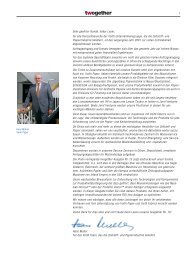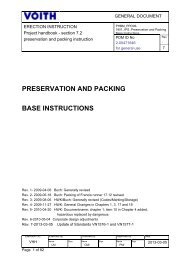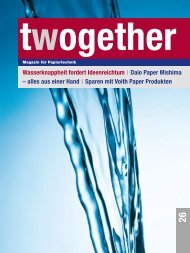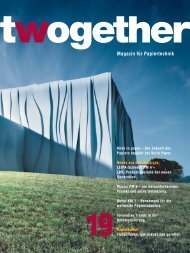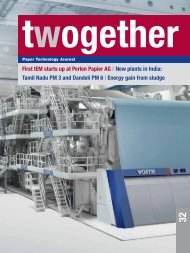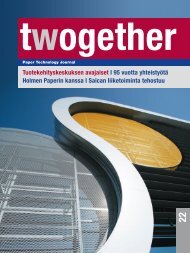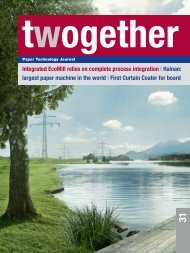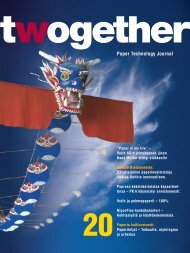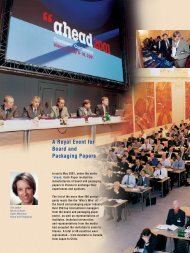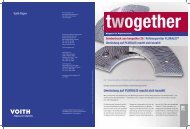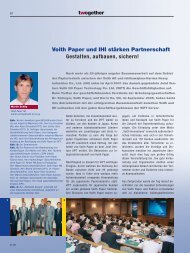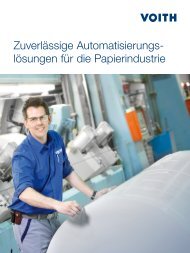Paper Technology Journal - Voith
Paper Technology Journal - Voith
Paper Technology Journal - Voith
Create successful ePaper yourself
Turn your PDF publications into a flip-book with our unique Google optimized e-Paper software.
2<br />
4<br />
5<br />
Density kg/m 3<br />
1300<br />
1200<br />
1100<br />
1000<br />
900<br />
800<br />
700<br />
600<br />
800<br />
1000 1200 1400<br />
Rewind diameter<br />
Nip force kN/m<br />
12<br />
10<br />
8<br />
6<br />
4<br />
2<br />
150<br />
Finishing<br />
Newsprint 680 kg/m 3<br />
a single drum winder had to be used. The<br />
reason for this were the nip forces resulting<br />
from the great roll weights which,<br />
with the two drum winder, could lead to<br />
winding faults, such as crepe wrinkles,<br />
breakages, excessive stretch etc. Fig. 3<br />
shows an example of 2 types of paper on<br />
this subject.<br />
Assuming therefore, that nip forces of<br />
4 or 5 kN/m are critical for the paper<br />
selected, a roll diameter of approx.<br />
1070 mm would be required for<br />
newsprint. This roll diameter would be<br />
considerably smaller for SC paper<br />
(approx. 980 mm). A standard two drum<br />
winder could therefore not be used with<br />
present-day typical rewind diameters<br />
of 1100-1250 mm – and particularly not<br />
for the diameters of 1500 mm required<br />
in the future. It was for this reason that<br />
in the past compressed air systems<br />
(Fig. 4) were used with two drum<br />
winders, so that the depositing forces<br />
resulting from the roll weight could be<br />
reduced.<br />
These requirements have been fully satisfied<br />
by the compressed air systems pro-<br />
SB-B/SC 1100 kg/m 3<br />
Fig. 1: Time table for taking over the<br />
responsibility for winders.<br />
Fig. 2: Field of activities for standard two<br />
drum winders and single drum winders.<br />
Fig. 3: Nip forces at two drum winders.<br />
Fig. 4: Conventional two drum winder roll<br />
with compressed air load relief.<br />
Fig. 5: TORO TD with compressed air load relief.<br />
Critical area<br />
Critical area<br />
300 450 600 750 900 1050 1200 1350 1500<br />
Rewind diameter<br />
51<br />
vided that the paper was air-permeable.<br />
However, as shown in Fig. 4, these standard<br />
installations have a technological<br />
disadvantage: The relieving air gets<br />
wound into the paper roll. With more<br />
dense types of paper, such as, for<br />
instance, improved newsprint and/or<br />
SC-B paper, the wound-in air causes<br />
layer displacements leading to crepe<br />
wrinkles even if the paper roll weights<br />
and the nip forces are low. The situation<br />
is still worse with high-finished or coated<br />
papers, as these types are almost impermeable<br />
to air, e.g. the included air really<br />
has no chance to escape.<br />
This, of course, leads to the question as<br />
to which modified winder concept we<br />
should adopt in the future. With this in<br />
mind, solutions such as belt supports<br />
and application of a soft cover on the<br />
winder drum etc. were discussed. It<br />
became clear, however, that these ideas<br />
were linked in part with other disadvantages.<br />
The best concept, in our opinion,<br />
is illustrated in Fig. 5.<br />
The solution is characterized by the following<br />
features:<br />
3



